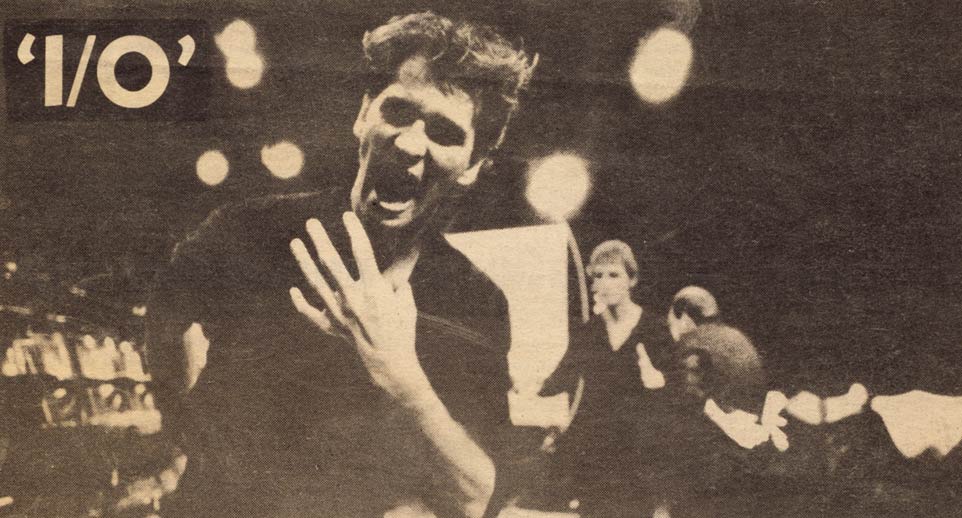I / O
A Ritual for 23 Performers by Roger Reynolds

I / O (1970) was performed as part of the 1982 Berkeley Stage Company Theater Festival of New Music, with direction by Robert MacDougall and choreography by Margaret Fisher. Seen above, Tony D’Amore, one of nine male mimes. Photo: Berkeley Stage Company.
Synopsis
Scored for nine female vocalists in white-face and dressed in black shrouds, nine male mimes, clarinet, two flutes, and two Technician/Performers, the this multi-media music theater piece includes live electronic processing and has the performers take their signals from projected geometric images. More about the work in the reviews below.
Credits
- Composer: Roger Reynolds
- Director: Robert MacDougall
- Choreographer: Margaret Fisher
- Lighting: Douglas Nelson
- Sound: Jim McKee, Barney Jones
- Sets: William Eddelman
- Costumes: Angela Paton, Suresa Dundes
- Dancers: Bill Bissell, Tony D'Amore, Martin Keogh, Heino Kolbe, Klaus Merten, Ricardo, Brad Stoller, Toyoji Peter Tomita, Julius Webster
Reviews
- “Reynolds’ Nirvana Minus 10,” Robert Commanday, San Francisco Chronicle, July 15, 1982. “Reynolds is a verbally oriented and philosophically inclined musician. His ‘I/O’ is an homage to Buckminster Fuller, created after his concept of ‘complementary opposites.’ Here that is stated as ‘I’ representing the Male, the singular, discontinuous, compressive, etc., and the ‘O’ or Female, plural, continuous, tensile, etc. In various and changing quadrilateral and spheroid forms, I and O are projected on large screens at opposite ends of the long, narrow playing area. The audience sits on the long side facing the nine who vocalize singly and together, as they are signaled to do by the play of a high-intensity flashlight beam on their countenances. All the long while a clarinet, two flutes, and, periodically, electronic music provide sustained, mostly blending, not individuated music, shifting tones slowly.
“Meanwhile, six male mimes course and shuttle on a geometric path (a triangle, two diamonds and a triangle, connected). Their refrain is a frantic swift pacing, intersecting and making fast reversals of field, like rats in a maze, sidewalk pedestrians. They mime different states of emotion and being. The conjunction of visual and aural activities serves as metaphors of living, being and becoming.
“There is another more disturbing refrain. Periodically, when two like images are thrown on the screens, harsh-looing spheres resembling brass gongs or moons, the vocalists turn to emotional venting, distress, anger or mirth. The mimes assume recumbent positions, in distorted or unblalanced forms. The message seems to be that while complementary opposites, the I and the O, generate positive life process; like forms, two spheres, generate tension and disruption. Clearly, Reynolds has enlarged on Fuller's concept, drawing it on to broader implications...
“The production itself found as much possibility in the work as the composer's framework offered, from my reading of it. All hands are to be congratulated, deserving high credit for craft and commitment in this collaborative and controlled kind of improvisatory theater. Margaret Fisher’s choreography was expressive of the ideas proposed in the score, keenly enacted. Robert MacDougall directed and coordinated the many different elements and made the experience integral....
“The venerable yet still highly peripatetic buckminster Fuller was in attendance, having come here specifically for the event. I hope he loved it, but I decided against asking.” - “An artistic output with her input,” Cathy Curtis, Berkeley Gaette, July 16, 1982. “A student of engineering physics in his own right, Reynolds interprets the idea of opposites through a highly structured blend of instrumental and computer-processed sound, singing, movement and slide projections.
“Ms. Fisher’s job was to animate the male mimes while staying within Reynold's structure, mapped out in a daunting score riddled with diagrams and precise details.
“‘Aesthetics are subordinate to the structure of the piece,’ says Ms. Fisher. ‘Whether the pitches of the singers sound lyrical or strident is secondary to the consideration that all rules be observed for interdependence. The changing of the slides is the one externally controlled, independent element; it acts as the timekeeper.’...
“‘Berkeley Stage has made a real breakthrough, first in providing the Festival of New Music and second in paying the performers,’ says Ms. Fisher. 'Being under the auspice of New Music sets a new standard for dance.’
“‘One of the mimes is among the world’s five best trombone players; another is a philosopher from Germany,’ she says. ‘All of them are interested in dance and theater and have stage experience of different degrees.’”